child seat VOLVO C30 2013 Owner´s Manual
[x] Cancel search | Manufacturer: VOLVO, Model Year: 2013, Model line: C30, Model: VOLVO C30 2013Pages: 300, PDF Size: 6.58 MB
Page 4 of 300
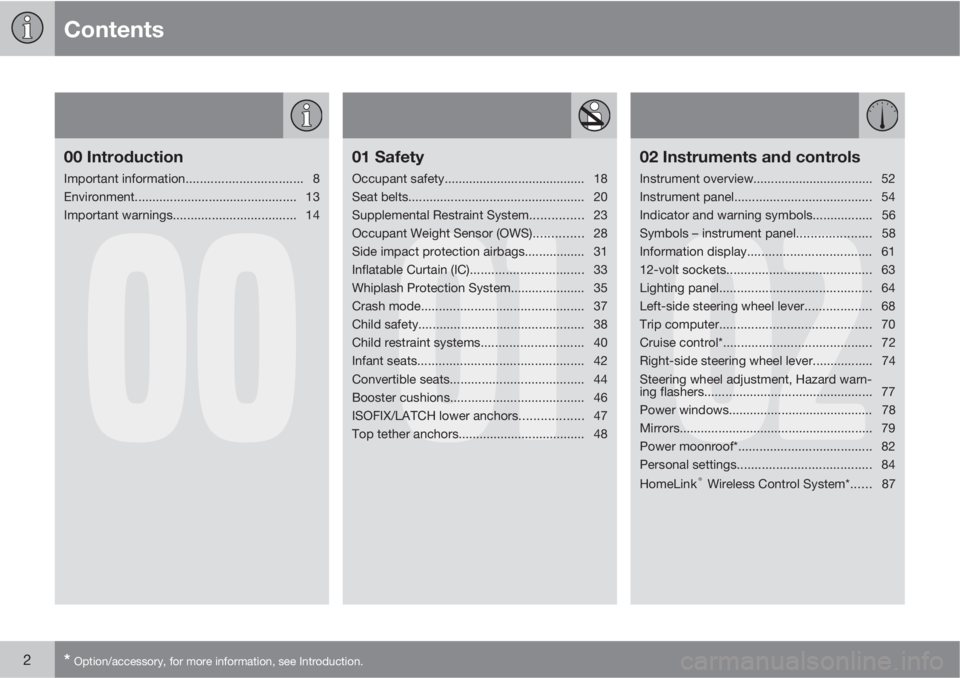
Contents
2* Option/accessory, for more information, see Introduction.
00
00 Introduction
Important information................................. 8
Environment.............................................. 13
Important warnings................................... 14
01
01 Safety
Occupant safety........................................ 18
Seat belts.................................................. 20
Supplemental Restraint System............... 23
Occupant Weight Sensor (OWS).............. 28
Side impact protection airbags................. 31
Inflatable Curtain (IC)................................ 33
Whiplash Protection System..................... 35
Crash mode.............................................. 37
Child safety............................................... 38
Child restraint systems............................. 40
Infant seats............................................... 42
Convertible seats...................................... 44
Booster cushions...................................... 46
ISOFIX/LATCH lower anchors.................. 47
Top tether anchors.................................... 48
02
02 Instruments and controls
Instrument overview.................................. 52
Instrument panel....................................... 54
Indicator and warning symbols.................56
Symbols – instrument panel..................... 58
Information display................................... 61
12-volt sockets......................................... 63
Lighting panel........................................... 64
Left-side steering wheel lever................... 68
Trip computer........................................... 70
Cruise control*.......................................... 72
Right-side steering wheel lever................. 74
Steering wheel adjustment, Hazard warn-
ing flashers................................................ 77
Power windows......................................... 78
Mirrors....................................................... 79
Power moonroof*...................................... 82
Personal settings...................................... 84
HomeLink
® Wireless Control System*...... 87
Page 18 of 300

16
Occupant safety...................................................................................... 18
Seat belts................................................................................................ 20
Supplemental Restraint System.............................................................. 23
Occupant Weight Sensor (OWS)............................................................. 28
Side impact protection airbags............................................................... 31
Inflatable Curtain (IC).............................................................................. 33
Whiplash Protection System................................................................... 35
Crash mode............................................................................................ 37
Child safety............................................................................................. 38
Child restraint systems........................................................................... 40
Infant seats.............................................................................................. 42
Convertible seats.................................................................................... 44
Booster cushions.................................................................................... 46
ISOFIX/LATCH lower anchors................................................................. 47
Top tether anchors.................................................................................. 48
Page 22 of 300
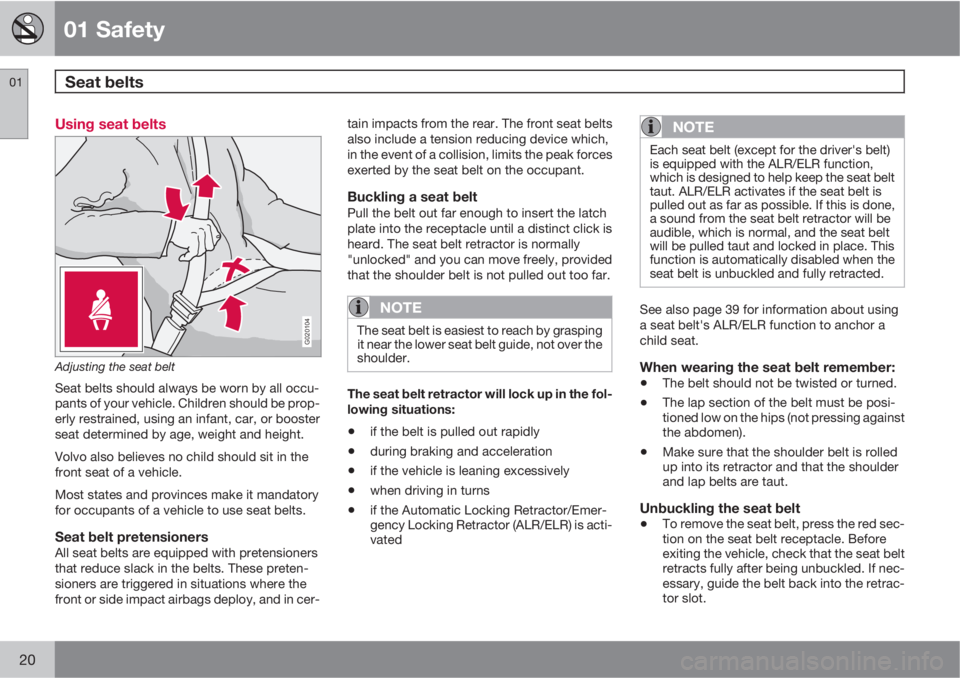
01 Safety
Seat belts 01
20
Using seat belts
G020104
Adjusting the seat belt
Seat belts should always be worn by all occu-
pants of your vehicle. Children should be prop-
erly restrained, using an infant, car, or booster
seat determined by age, weight and height.
Volvo also believes no child should sit in the
front seat of a vehicle.
Most states and provinces make it mandatory
for occupants of a vehicle to use seat belts.
Seat belt pretensionersAll seat belts are equipped with pretensioners
that reduce slack in the belts. These preten-
sioners are triggered in situations where the
front or side impact airbags deploy, and in cer-tain impacts from the rear. The front seat belts
also include a tension reducing device which,
in the event of a collision, limits the peak forces
exerted by the seat belt on the occupant.
Buckling a seat beltPull the belt out far enough to insert the latch
plate into the receptacle until a distinct click is
heard. The seat belt retractor is normally
"unlocked" and you can move freely, provided
that the shoulder belt is not pulled out too far.
NOTE
The seat belt is easiest to reach by grasping
it near the lower seat belt guide, not over the
shoulder.
The seat belt retractor will lock up in the fol-
lowing situations:
•if the belt is pulled out rapidly
•during braking and acceleration
•if the vehicle is leaning excessively
•when driving in turns
•if the Automatic Locking Retractor/Emer-
gency Locking Retractor (ALR/ELR) is acti-
vated
NOTE
Each seat belt (except for the driver's belt)
is equipped with the ALR/ELR function,
which is designed to help keep the seat belt
taut. ALR/ELR activates if the seat belt is
pulled out as far as possible. If this is done,
a sound from the seat belt retractor will be
audible, which is normal, and the seat belt
will be pulled taut and locked in place. This
function is automatically disabled when the
seat belt is unbuckled and fully retracted.
See also page 39 for information about using
a seat belt's ALR/ELR function to anchor a
child seat.
When wearing the seat belt remember:
•The belt should not be twisted or turned.
•The lap section of the belt must be posi-
tioned low on the hips (not pressing against
the abdomen).
•Make sure that the shoulder belt is rolled
up into its retractor and that the shoulder
and lap belts are taut.
Unbuckling the seat belt
•To remove the seat belt, press the red sec-
tion on the seat belt receptacle. Before
exiting the vehicle, check that the seat belt
retracts fully after being unbuckled. If nec-
essary, guide the belt back into the retrac-
tor slot.
Page 23 of 300
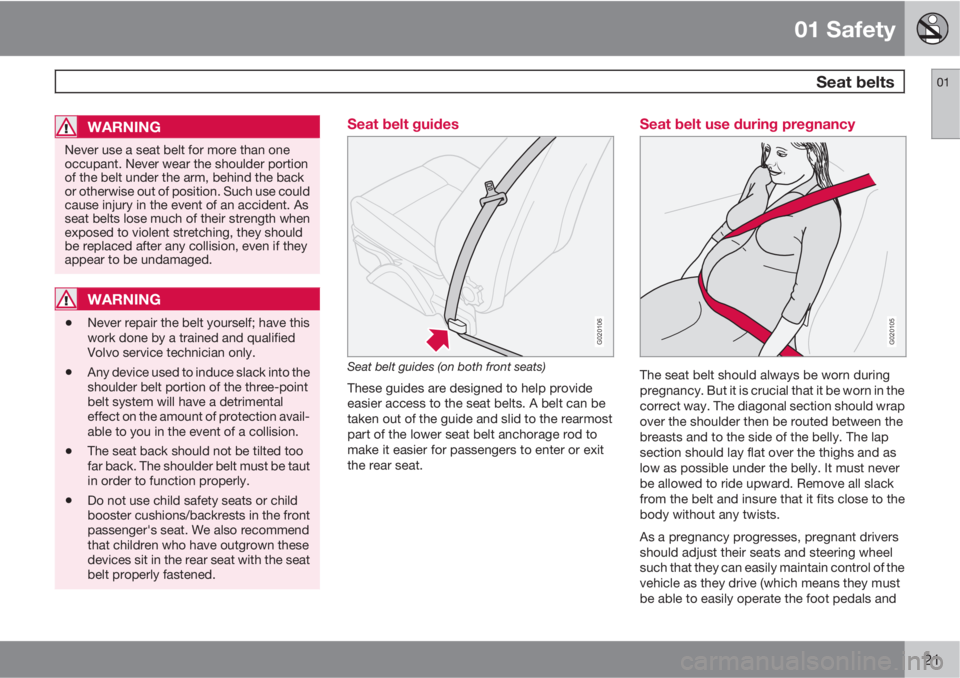
01 Safety
Seat belts01
21
WARNING
Never use a seat belt for more than one
occupant. Never wear the shoulder portion
of the belt under the arm, behind the back
or otherwise out of position. Such use could
cause injury in the event of an accident. As
seat belts lose much of their strength when
exposed to violent stretching, they should
be replaced after any collision, even if they
appear to be undamaged.
WARNING
•Never repair the belt yourself; have this
work done by a trained and qualified
Volvo service technician only.
•Any device used to induce slack into the
shoulder belt portion of the three-point
belt system will have a detrimental
effect on the amount of protection avail-
able to you in the event of a collision.
•The seat back should not be tilted too
far back. The shoulder belt must be taut
in order to function properly.
•Do not use child safety seats or child
booster cushions/backrests in the front
passenger's seat. We also recommend
that children who have outgrown these
devices sit in the rear seat with the seat
belt properly fastened.
Seat belt guides
G020106
Seat belt guides (on both front seats)
These guides are designed to help provide
easier access to the seat belts. A belt can be
taken out of the guide and slid to the rearmost
part of the lower seat belt anchorage rod to
make it easier for passengers to enter or exit
the rear seat.
Seat belt use during pregnancy
G020105
The seat belt should always be worn during
pregnancy. But it is crucial that it be worn in the
correct way. The diagonal section should wrap
over the shoulder then be routed between the
breasts and to the side of the belly. The lap
section should lay flat over the thighs and as
low as possible under the belly. It must never
be allowed to ride upward. Remove all slack
from the belt and insure that it fits close to the
body without any twists.
As a pregnancy progresses, pregnant drivers
should adjust their seats and steering wheel
such that they can easily maintain control of the
vehicle as they drive (which means they must
be able to easily operate the foot pedals and
Page 24 of 300
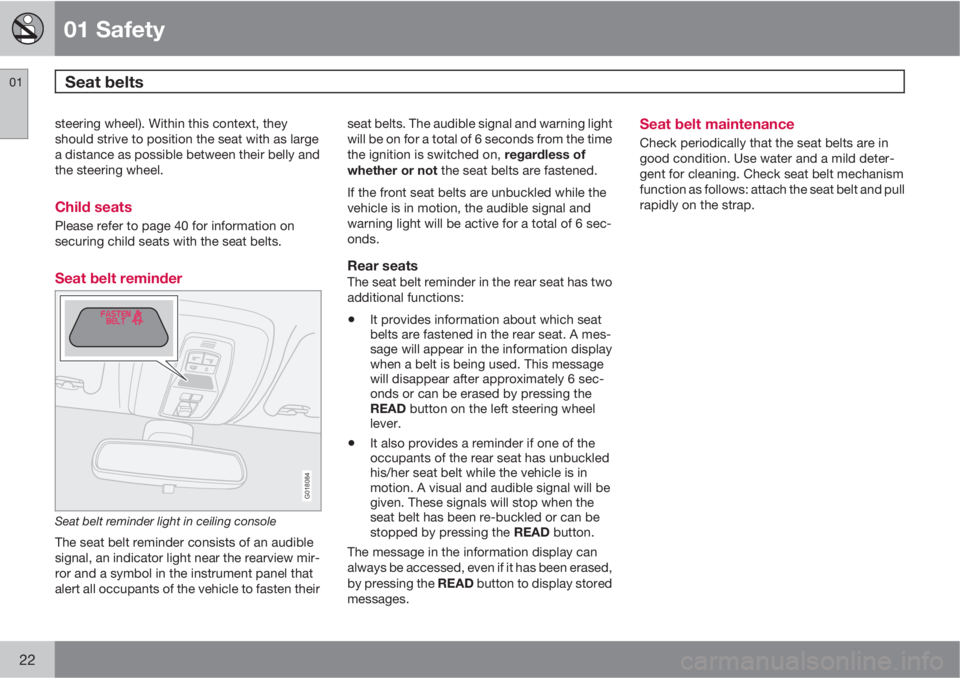
01 Safety
Seat belts 01
22
steering wheel). Within this context, they
should strive to position the seat with as large
a distance as possible between their belly and
the steering wheel.
Child seats
Please refer to page 40 for information on
securing child seats with the seat belts.
Seat belt reminder
G018084
Seat belt reminder light in ceiling console
The seat belt reminder consists of an audible
signal, an indicator light near the rearview mir-
ror and a symbol in the instrument panel that
alert all occupants of the vehicle to fasten theirseat belts. The audible signal and warning light
will be on for a total of 6 seconds from the time
the ignition is switched on, regardless of
whether or not the seat belts are fastened.
If the front seat belts are unbuckled while the
vehicle is in motion, the audible signal and
warning light will be active for a total of 6 sec-
onds.
Rear seatsThe seat belt reminder in the rear seat has two
additional functions:
•It provides information about which seat
belts are fastened in the rear seat. A mes-
sage will appear in the information display
when a belt is being used. This message
will disappear after approximately 6 sec-
onds or can be erased by pressing the
READ button on the left steering wheel
lever.
•It also provides a reminder if one of the
occupants of the rear seat has unbuckled
his/her seat belt while the vehicle is in
motion. A visual and audible signal will be
given. These signals will stop when the
seat belt has been re-buckled or can be
stopped by pressing the READ button.
The message in the information display can
always be accessed, even if it has been erased,
by pressing the READ button to display stored
messages.
Seat belt maintenance
Check periodically that the seat belts are in
good condition. Use water and a mild deter-
gent for cleaning. Check seat belt mechanism
function as follows: attach the seat belt and pull
rapidly on the strap.
Page 28 of 300

01 Safety
Supplemental Restraint System 01
26
WARNING
•Do not use child safety seats or child
booster cushions/backrests in the front
passenger's seat. We also recommend
that occupants under 4 feet 7 inches
(140 cm) in height who have outgrown
these devices sit in the rear seat with the
seat belt fastened
1.
•Never drive with the airbags deployed.
The fact that they hang out can impair
the steering of your vehicle. Other
safety systems can also be damaged.
•The smoke and dust formed when the
airbags are deployed can cause skin
and eye irritation in the event of pro-
longed exposure.
Passenger's side airbag decal
G032934
Airbag decal on the outside of both sun visors
1See also the Occupant Weight Sensor information on page 28.
Page 29 of 300
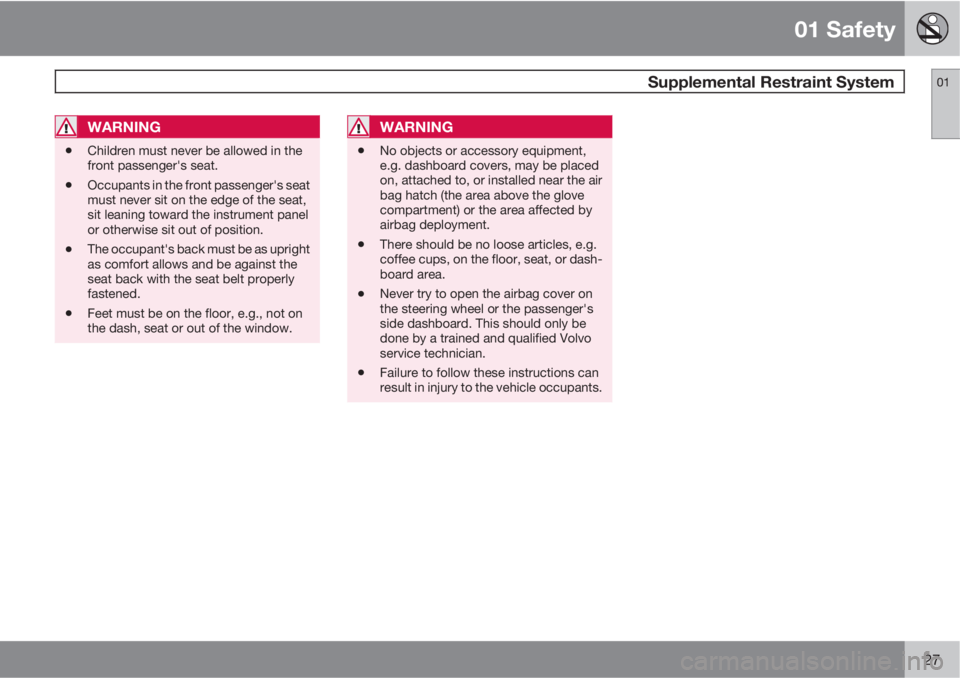
01 Safety
Supplemental Restraint System01
27
WARNING
•Children must never be allowed in the
front passenger's seat.
•Occupants in the front passenger's seat
must never sit on the edge of the seat,
sit leaning toward the instrument panel
or otherwise sit out of position.
•The occupant's back must be as upright
as comfort allows and be against the
seat back with the seat belt properly
fastened.
•Feet must be on the floor, e.g., not on
the dash, seat or out of the window.
WARNING
•No objects or accessory equipment,
e.g. dashboard covers, may be placed
on, attached to, or installed near the air
bag hatch (the area above the glove
compartment) or the area affected by
airbag deployment.
•There should be no loose articles, e.g.
coffee cups, on the floor, seat, or dash-
board area.
•Never try to open the airbag cover on
the steering wheel or the passenger's
side dashboard. This should only be
done by a trained and qualified Volvo
service technician.
•Failure to follow these instructions can
result in injury to the vehicle occupants.
Page 30 of 300

01 Safety
Occupant Weight Sensor (OWS) 01
28
Disabling the passenger's side front
airbag
2
G018082
Occupant Weight Sensor (OWS) indicator light
Volvo recommends that ALL occupants (adults
and children) shorter than 4 feet 7 inches
(140 cm) be seated in the rear seat of any vehi-
cle with a passenger's side front airbag, and be
properly restrained. Children should always be
seated in child restraints appropriate for their
size and weight. See also the child safety rec-
ommendations on page 38.
The Occupant Weight Sensor (OWS) is
designed to meet the regulatory requirements
of Federal Motor Vehicle Safety Standard
(FMVSS) 208 and is designed to disable (willnot inflate) the passenger's side front airbag
under certain conditions.
The OWS works with sensors that are part of
the front passenger's seat and seat belt. The
sensors are designed to detect the presence of
a properly seated occupant and determine if
the passenger's side front airbag should be
enabled (may inflate) or disabled (will not
inflate).
The OWS will disable (will not inflate) the pas-
senger's side front airbag when:
•the front passenger's seat is unoccupied,
or has small/medium objects in the front
seat,
•the system determines that an infant is
present in a rear-facing infant seat that is
installed according to the manufacturer's
instructions,
•the system determines that a small child is
present in a forward-facing child restraint
that is installed according to the manufac-
turer's instructions,
•the system determines that a small child is
present in a booster seat,
•a front passenger takes his/her weight off
of the seat for a period of time,
•a child or a small person occupies the front
passenger's seat.The OWS uses a PASSENGER AIRBAG OFF
indicator lamp which will illuminate and stay on
to remind you that the passenger's side front
airbag is disabled. The PASSENGER AIRBAG
OFF indicator lamp is located in the overhead
console, near the base of the rearview mirror.
NOTE
When the ignition is switched on, the OWS
indicator light will go on for up to 10 seconds
while the system performs a self-diagnostic
test.
However, if a fault is detected in the system:
•The OWS indicator light will stay on
•The SRS warning light (see page 23) will
come on and stay on
The message
PASS. AIRBAG OFF SERVICE
URGENT will be displayed in the information
display.
Page 31 of 300

01 Safety
Occupant Weight Sensor (OWS)01
29
WARNING
If a fault in the system is detected and indi-
cated as explained on the preceding page,
be aware that the passenger's side front air-
bag will not deploy in the event of a collision.
In this case, the SRS system and Occupant
Weight Sensor should be inspected by a
trained and qualified Volvo service techni-
cian as soon as possible.
WARNING
•Never try to open, remove, or repair any
components in the OWS system. This
could result in system malfunction.
Maintenance or repairs should only be
carried out by an a trained and qualified
Volvo service technician.
•The front passenger's seat should not
be modified in any way. This could
reduce pressure on the seat cushion,
which might interfere with the OWS sys-
tem's function.
The OWS is designed to disable (will not inflate)
the passenger's side front airbag when a rear
facing infant seat, a forward-facing child
restraint, or a booster seat is detected. The
PASSENGER AIRBAG OFF indicator lamp will
illuminate and stay on to remind you that thepassenger's side front airbag is disabled (see
the following table).
Passenger's
seat occu-
pancy statusOWS indica-
tor light sta-
tusPassenger's
side front
airbag sta-
tus
Seat unoc-
cupiedOWS indica-
tor light
lights
up
Passenger's
side front
airbag disa-
bled
Seat occu-
pied by low
weight
occupant/
object
A
OWS indica-
tor light
lights
up
Passenger's
side front
airbag disa-
bled
Seat occu-
pied by
heavy occu-
pant/objectOWS indica-
tor light
is not
lit
Passenger's
side front
airbag ena-
bled
AVolvo recommends that children always be properly
restrained in appropriate child restraints in the rear seats. Do
not assume that the passenger's side front airbag is disabled
unless the PASSENGER AIRBAG OFF indicator lamp is lit.
Make sure the child restraint is properly installed. If there is
any doubt as to the status of the passenger's side front air-
bag, move the child restraint to the rear seat.
The OWS is designed to enable (may inflate)
the passenger's side front airbag in the event
of a collision anytime the system senses that aperson of adult size is sitting properly in the
front passenger's seat. The PASSENGER
AIRBAG OFF indicator lamp will be off and
remain off.
If a person of adult size is sitting in the front
passenger's seat, but the PASSENGER
AIRBAG OFF indicator lamp is on, it is possible
that the person isn't sitting properly in the seat.
If this happens:
1. Turn the vehicle off and ask the person to
place the seatback in an upright position.
2. Have the person sit upright in the seat,
centered on the seat cushion, with the per-
son's legs comfortably extended.
3. Restart the vehicle and have the person
remain in this position for about two
minutes. This will allow the system to
detect that person and enable the pas-
senger's frontal airbag.
4.
If the PASSENGER AIRBAG OFF indicator
lamp remains on even after this, the person
should be advised to ride in the rear seat.
This condition reflects limitations of the OWS
classification capability. It does not indicate
OWS malfunction.ModificationsIf you are considering modifying your vehicle in
any way to accommodate a disability, for
Page 32 of 300

01 Safety
Occupant Weight Sensor (OWS) 01
30
example by altering or adapting the driver's or
front passenger's seat(s) and/or airbag sys-
tems, please contact Volvo at:
In the USA
Volvo Cars of North America, LLC
Customer Care Center
1 Volvo Drive
P.O. Box 914
Rockleigh, New Jersey 07647
1-800-458-1552
In Canada
Volvo Cars of Canada Corp.
National Customer Service
175 Gordon Baker Road North York, Ontario
M2H 2N7
1-800-663-8255WARNING
•No objects that add to the total weight
on the seat should be placed on the
front passenger's seat. If a child is
seated in the front passenger's seat
with any additional weight, this extra
weight could cause the OWS system to
enable the airbag, which might cause it
to deploy in the event of a collision,
thereby injuring the child.
•The seat belt should never be wrapped
around an object on the front passeng-
er's seat. This could interfere with the
OWS system's function.
•The front passenger's seat belt should
never be used in a way that exerts more
pressure on the passenger than normal.
This could increase the pressure exer-
ted on the weight sensor by a child, and
could result in the airbag being enabled,
which might cause it to deploy in the
event of a collision, thereby injuring the
child.
WARNING
Keep the following points in mind with
respect to the OWS system. Failure to follow
these instructions could adversely affect the
system's function and result in serious injury
to the occupant of the front passenger's
seat:
•The full weight of the front seat passen-
ger should always be on the seat cush-
ion. The passenger should never lift
him/herself off the seat cushion using
the armrest in the door or the center
console, by pressing the feet on the
floor, by sitting on the edge of the seat
cushion, or by pressing against the
backrest in a way that reduces pressure
on the seat cushion. This could cause
OWS to disable the passenger's side
front airbag.
•Do not place any type of object on the
front passenger's seat in such a way
that jamming, pressing, or squeezing
occurs between the object and the front
seat, other than as a direct result of the
correct use of the Automatic Locking
Retractor/Emergency Locking Retrac-
tor (ALR/ELR) seat belt, see page 39.
•No objects should be placed under the
front passenger's seat. This could inter-
fere with the OWS system's function.